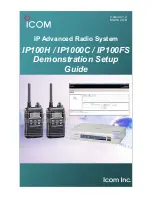
CONVENTIONAL FEATURES
32
NAC may need to be transmitted by your radio for
them to receive your call (see Sections 5.5 and 5.16.3).
Placing a Standard Conventional Call
1. Turn power on and set the volume as described in
Section 3.1 on page 13. Select the channel
programmed for the mobile you want to call (see
Section 3.4.2 on page 14).
2. Monitor the channel automatically or manually as
described in Section 5.2 on page 25.
3. Press the PTT switch and if the Busy Channel
Lockout feature is programmed on the channel, the
transmitter is automatically disabled if the channel
is busy (see Section 5.4). Otherwise, busy and out-
of-range conditions are not indicated and speaking
can begin after monitoring the channel.
4. Press (and hold) the PTT switch to talk and release
it to listen. When the call is finished, place the
microphone back on-hook.
Receiving a Standard Conventional Call
1. Select or scan the channel programmed for the call
you want to receive (refer to Section 5.11 for more
scanning information).
2. When the call is received, take the microphone off-
hook and press the PTT switch to talk and release it
to listen. If scanning, responses may occur on the
priority, selected, or receive channel as described in
Section 5.11.3.
3. When the call is finished, place the microphone
back on-hook.
5.13 DTMF/ANI SIGNALING
DTMF (Dual Tone Multi-Frequency) tones can
be generated for ANI (Automatic Number Identifica-
tion) and other purposes on conventional analog
channels. One of the following options may be
enabled on each channel:
Pre-Tx ANI -
A preprogrammed ANI sequence is
automatically sent each time the PTT switch is
pressed.
Post-Tx ANI -
A preprogrammed ANI sequence is
automatically sent each time the PTT switch is
released.
When an emergency alarm or call is placed, this
ANI signaling is replaced by the Emergency DTMF
ID (see Section 5.10). Refer to Section 5.15 for infor-
mation on MDC1200 ANI.
5.14 SINGLE TONE ENCODER
This feature is not available with the 5300
mobile. It is available with the 5100 portable only.
5.15 MDC1200 COMPATIBILITY
MDC1200 is a signaling protocol designed and
implemented by Motorola for analog channels only.
The following features of this protocol are supported.
Either MDC1200 or standard DTMF ANI/Emergency
signaling can be programmed on each conventional
system.
NOTE: This feature is available only with
radio platforms that use Version 4.2 or later firmware
(it is also hardware dependent and therefore cannot be
added to others by simply upgrading firmware).
MDC1200 ANI - Both pre and post ANI are
supported.
MDC1200 Emergency Alert - A retry counter is
implemented. Currently, ACKs are not decoded so the
radio retrys the programmed number of times with
each emergency.
5.16 PROJECT 25 MODE FEATURES
NOTE: The following features are unique to
conventional P25 channels.
5.16.1 UNIT ID CODE
Each radio that operates on Project 25 (digital)
channels is programmed with an eight-digit unit ID.
This ID is unique for each radio and can be any number
from 1-16,777,216. When power is turned on with a
Project 25 channel selected, this ID is briefly displayed.
5.16.2 GROUP ID CODE
Each Project 25 channel is programmed with a
group ID that determines which group of mobiles will
















































